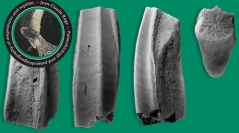

 Comptes Rendus Palevol
20 (7) - Pages 91-117
Comptes Rendus Palevol
20 (7) - Pages 91-117The Quintanilla la Ojada section (Basque-Cantabrian Region, northern Spain) has yielded two assemblages of Late Cretaceous vertebrates, deposited during the Maastrichtian in coastal environments and related to a transgressive lag at the base of the Valdenoceda Formation. Numerous teeth of Elasmobranchii and Actinopterygii are the most prevailing fossil material, although scarce teeth of marine reptiles (Mosasauridae) and dinosaurs (Hadrosauridae) also occur. The presence of one hadrosaurian tooth, a terrestrial taxon, constitutes the first report of ornithischians in the Valdenoceda Formation. The fossil vertebrate association of Quintanilla la Ojada is similar to that discovered in Albaina (Treviño County, Burgos), also located in the Basque-Cantabrian Region, although relatively younger in age. Both fossil sites are characterised by a mixture of taxa from the northern and southern margins of the Mediterranean Tethys (north-European and north-African outcrops).
Noselachians, actinopterygians, mosasaurids, hadrosaurians, Maastrichtian, Iberian Peninsula